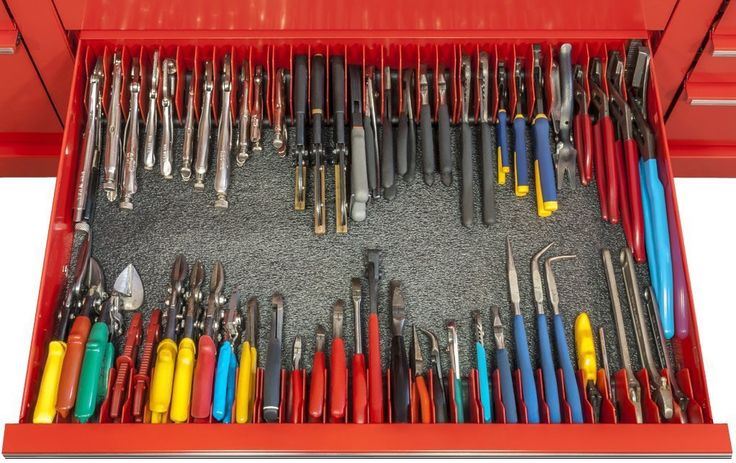Do you want to know how to organize tools in your toolbox like a pro? If you are tired of wasting time and energy looking for the right tool in a messy and cluttered toolbox, then this article is for you.
In this article, we will show you 10 easy and effective ways to organize your tools in your toolbox, whether you have a portable toolbox, a tool bag, or a tool chest.
By following these tips, you will be able to organize and find any tool you need quickly and easily, and also protect your tools from damage and theft.

Table of contents
- What are the Different Types of Toolboxes?
- How to Choose the Best Toolbox for Your Needs?
- How to Sort and Categorize Your Tools Before Organizing Them?
- How to Use Tool Foam Organizers to Create Custom Layouts for Your Tools?
- How to Use Pegboards and Accessories to Store and Display Your Tools?
- How to Use Tool Shadow Boards to Quickly Identify and Locate Your Tools?
- How to Use Tool Trays and Dividers to Separate and Organize Your Tools?
- How to Use Magnetic Strips and Hooks to Hang and Secure Your Tools?
- FAQs
- Conclusion
- References
- Recommendations
What are the Different Types of Toolboxes?
There are many types of toolboxes available in the market, each with its own advantages and disadvantages. Depending on the size, shape, and number of tools you have, and the frequency and location of your work, you may need different types of toolboxes to suit your needs.
Here are some of the most common types of toolboxes and how to choose the best one for your needs:
#1. Portable Toolboxes

These are small and lightweight toolboxes that can hold a few basic tools for home projects or minor repairs. They are easy to carry and store and are ideal for occasional or hobby use.
However, they may not have enough space or compartments to organize a large or diverse collection of tools. Some examples of portable toolboxes are the DEWALT TSTAK Toolbox and the Stanley 19-inch Toolbox.
See also: 5 Expert Tools You Need for Demolition
#2. Tool Bags

These are soft-sided toolboxes that can store tools in pockets on the outside and inside. They are preferred by those who use a lot of small hand tools like screwdrivers, pliers, and cutters, as they can access them quickly and easily. They also have shoulder straps or handles that make them comfortable to carry and leave the hands free.
However, they may not offer enough protection or stability for delicate or heavy tools. Some examples of tool bags are Custom Leathercraft Tool Bag and WORKPRO 16-inch Wide Mouth Tool Bag.
See also: 10 Best Tools for Small Businesses | Best Tools
#3. Tool Chests

These are large and sturdy toolboxes that have several sliding drawers and compartments. They are often used by mechanics, electricians, and carpenters, who need to organize a lot of power tools, hand tools, fixtures, and fittings. They also have wheels or casters that make them easy to move around.
However, they may be too bulky or heavy to transport or store in small spaces. Some examples of tool chests are Craftsman Tool Chest and Keter Rolling Tool Chest.
See also: 10 Best Tools For Cutting Drywall In | Best Tools
How to Choose the Best Toolbox for Your Needs?
To choose the best type of toolbox for your needs, you should consider the following factors:
- The size and weight of your tools: You should choose a toolbox that can fit and support your tools comfortably, without being too big or small, or too heavy or light. You should also consider the shape and layout of your tools, and how they can be arranged in the toolbox.
- The frequency and location of your work: You should choose a toolbox that can match your work style and environment. If you work often and in different locations, you may need a toolbox that is portable, durable, and easy to carry. If you work rarely and at home, you may need a toolbox that is simple, compact, and easy to store.
- The level of organization and accessibility you need: You should choose a toolbox that can help you organize and access your tools efficiently and conveniently. If you need to find and use your tools quickly and frequently, you may need a toolbox that has multiple compartments, pockets, and labels. If you need to protect and secure your tools from damage or theft, you may need a toolbox that has locks, lids, and foam inserts.
See also: How to Fix Broken Window Glass – How to Repair Windows:
How to Sort and Categorize Your Tools Before Organizing Them?
Before organizing your tools in your toolbox, sort and categorize them by type, function, size, and use. This will help you store them logically and efficiently. To sort and categorize your tools, follow these steps:
- Collect your tools and spread them on a large surface.
- Remove any broken, worn, or unwanted tools. Repair, replace, donate, or discard them.
- Group your tools by type and function, such as hammers, screwdrivers, etc. Subdivide them by size, shape, or use, such as claw hammers, Phillips screwdrivers, etc.
- Label each group with a name, such as “Hammers”, “Screwdrivers”, etc. Use sticky notes, tape, or markers.
- Prioritize your tools by use, such as daily, weekly, etc. Use colors or numbers to mark them.
- Arrange your tools by priority within each group. This will help you place them in the best locations in your toolbox.
See also: How to Get Rid of Ground Hornets
How to Use Tool Foam Organizers to Create Custom Layouts for Your Tools?

One of the best ways to organize your tools in your toolbox is to use tool foam organizers. Tool foam organizers are sheets of foam that you can cut and shape to fit your tools and your toolbox. They are ideal for creating custom tool layouts and keeping your tools in place.
To use tool foam organizers, you will need to measure your toolbox and your tools and cut the foam sheets accordingly. You can use a utility knife, a hot knife, or a foam cutter to cut the foam. You can also use a marker, a ruler, or a template to trace the outlines of your tools on the foam.
Then, you will need to remove the foam pieces that correspond to your tools and create recesses for them. You can use a pair of scissors, a drill, or a router to remove the foam. You can also use a heat gun or a hair dryer to smooth the edges of the foam.
Finally, you will need to insert the foam sheets into your toolbox and place your tools in the recesses. You can use glue, tape, or Velcro to secure the foam sheets in your toolbox. You can also use different colors of foam to create a shadow board effect and make your tools stand out.
See also: How to Measure Square Footage | Learn this now
How to Use Pegboards and Accessories to Store and Display Your Tools?

Pegboards are boards with holes for hooks, baskets, shelves, and holders to store and display your tools on the wall. They save space, increase visibility, and let you customize and rearrange your tools.
To use pegboards and accessories, follow these steps:
- Measure the wall space for your pegboard.
- Order or buy a pegboard that fits your wall space. Choose the material, color, and size you prefer. For example, Wall Control Metal Pegboard or Azar Plastic Pegboard.
- Install your pegboard on the wall with screws, anchors, or brackets. Leave some gaps between the pegboard and the wall for the hooks and accessories. Use spacers, washers, or furring strips to create the gap. Make sure the pegboard is level and secure.
- Plan and sketch your tools’ layout on the pegboard. Consider their size, shape, and priority, and how to arrange them efficiently and aesthetically.
- Transfer your tools’ layout onto the pegboard with hooks and accessories. Use different types of hooks, baskets, shelves, and holders that suit your tools’ size, shape, weight, and function. Insert them into the pegboard’s holes and adjust them as needed. For example, Pegboard Hooks Assortment or Pegboard Bins and Shelves.
- Place your tools on the pegboard’s hooks and accessories. Label them with their names or numbers. Add some pictures or illustrations to make your pegboard attractive and appealing.
See also: How to Repair Small Appliances: Full Tips and Guidelines
How to Use Tool Shadow Boards to Quickly Identify and Locate Your Tools?

Tool shadow boards are boards with tool shapes painted or printed on them. They help you find and match your tools with their shadows. They also stop you from losing or forgetting your tools.
To use tool shadow boards, follow these steps:
- Measure the board or surface for your tool shadow board.
- Order or buy a board that fits your board or surface. Choose the material, color, and thickness you like. For example, Foam Board or Plywood Board.
- Lay your board or surface flat on a large and clean area.
- Arrange your tools on the board or surface as you want them to be organized and displayed. Use the same steps as you did for sorting and categorizing your tools.
- Trace your tools’ shapes on the board or surface with a pencil, a pen, or a marker. Trace them accurately and neatly, leaving some space between them.
- Remove your tools from the board or surface carefully, without smudging or erasing the lines.
- Paint or print your tools’ shapes on the board or surface with paint, a spray, or a printer. Choose the color, shade, and pattern you prefer. Paint or print within the lines, and let them dry.
- Install your board or surface on the wall or the toolbox with screws, nails, or glue. Make sure it is level and secure.
- Place your tools on the board or surface, matching them with their shapes. Label them with their names or numbers. Add some pictures or illustrations to make your tool shadow board attractive and appealing.
See also: How To Get Gum From Shoes
How to Use Tool Trays and Dividers to Separate and Organize Your Tools?

Tool trays and dividers are tools that separate and organize your tools in your toolbox or drawer. They keep your tools neat and tidy and stop them from sliding or clashing. They also group and categorize your tools by type, function, size, or use.
To use tool trays and dividers, follow these steps:
- Measure your toolbox or drawer for tool trays and dividers.
- Order or buy tool trays and dividers that fit your toolbox or drawer. Choose the material, shape, and size you prefer. For example, Ernst Tool Organizer Tray or Adjustable Drawer Dividers.
- Insert tool trays and dividers in your toolbox or drawer. Secure and adjust them as needed, to create sections or compartments for your tools.
- Place your tools in tool trays and dividers. Label them with their names or numbers. Add some pictures or illustrations to make them attractive and appealing.
See also: How to Make Homemade Dog Repellent
How to Use Magnetic Strips and Hooks to Hang and Secure Your Tools?

Magnetic strips and hooks are tools that use magnets to hang and secure your tools on the wall or the toolbox. They save space, avoid drilling or screwing, and let you store and display your tools easily and quickly. They also stop your tools from falling or getting lost.
To use magnetic strips and hooks, follow these steps:
- Measure your wall or toolbox for magnetic strips and hooks.
- Order or buy magnetic strips and hooks that fit your wall or toolbox. Choose the material, strength, and size you prefer. For example, Master Magnetics Magnetic Tool Holder or Magnetic Hooks.
- Install magnetic strips and hooks on your wall or toolbox. Secure and adjust them as needed, to suit your tools.
- Hang your tools on magnetic strips and hooks. Label them with their names or numbers. Add some pictures or illustrations to make them attractive and appealing.
See also: How to Clean Bathtub Jets
FAQs
It’s not a bad idea to begin by sorting everything into a few different categories. Put all the hand tools in one spot, all the power tools in another, and anything you consider a seasonal tool in its own pile. Once you’ve done this, you’ll be off to a great start.
The three common methods of organizing writing are chronological order, spatial order, and order of importance. You need to keep these methods of organization in mind as you plan how to arrange the information you have gathered in an outline.
Toolboxes and cabinets usually consist of an individual or group of drawers or cribs for storage and organization of tools, which may also be ergonomic and allow for growth and adjustments. The addition of rollers on boxes and cabinets, especially large ones, allows for portability in home or work environments.
Conclusion
Organizing your tools in your toolbox is not only a matter of convenience, but also a matter of productivity, safety, and satisfaction. By following the tips and hacks in this article, you can transform your toolbox into a functional and convenient workspace that will make your life easier.
You can also enjoy the benefits of having a well-organized toolbox, such as saving time, money, and energy, improving your efficiency and quality of work, and increasing your safety and comfort. So, what are you waiting for? Start organizing your tools in your toolbox today, and see the difference for yourself!
References
- Bobvila.com – How to Organize a Toolbox Like a Pro
- Creativesafetysupply.com – Top Tool Organization Strategies for the Workplace





